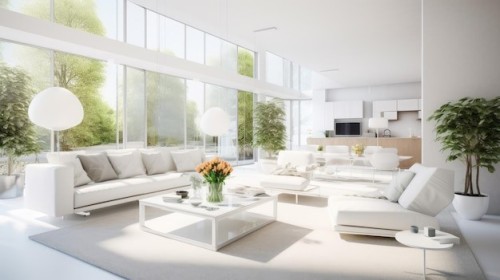Matthew Benning
By Matthew Benning
In the last decade, the housing market has undergone significant transformations to meet the demands of a dynamic social climate. As consumers become increasingly passionate about issues such as climate change, sustainability, and minimalism, the Home Improvement Research Institute (HIRI) partnered with Trend Hunter to explore what the future of housing may look like. This collaboration resulted in the “Future of Housing Trend Report,” which identifies three emerging trends in neighborhood design and sustainable living practices. From the use of eco-friendly materials and 3D-printed technology to designs inspired by different cultures and reversible architecture, the housing market is poised to continue evolving as consumer mindsets shift. In this article, we will delve into these emerging trends and explore how they may impact your business.
Hyper-Local Neighborhoods: Building Strong Communities
One of the prominent trends identified in the “Future of Housing Trend Report” is the rise of hyper-local neighborhoods. Architects, developers, and local governments are proposing the creation of neighborhoods that prioritize community building and support local businesses. These neighborhoods aim to be car-free, with all necessities within a short walking or biking distance.
The Rise of Hyper-Local Neighborhoods
As urban centers expand in size and population, many individuals are recognizing that their quality of life is suffering. Alienation, affordability issues, lengthy commutes, and pollution are some of the concerns driving people away from city centers. To address these challenges, hyper-local neighborhoods are emerging as an attractive alternative. By fostering a sense of belonging and enabling stronger connections with nearby residents, these neighborhoods provide convenience and cleaner air.
Benefits of Hyper-Local Neighborhoods
The shift towards hyper-local neighborhoods offers numerous benefits for both residents and businesses. For residents, this model provides a heightened sense of community, allowing them to build meaningful relationships with their neighbors. Additionally, the proximity of essential amenities reduces the need for long commutes and creates a more sustainable lifestyle. From a business perspective, hyper-local neighborhoods present opportunities for local establishments to thrive. With a concentrated customer base, businesses within these communities can develop strong customer loyalty and benefit from increased foot traffic.
Designing Hyper-Local Neighborhoods
Creating successful hyper-local neighborhoods requires careful planning and design. Developers and architects should prioritize mixed-use spaces that combine residential, commercial, and community areas. Green spaces and pedestrian-friendly infrastructure are essential components that contribute to the overall well-being of residents. Additionally, fostering a sense of inclusivity and diversity within the neighborhood can further enhance the community spirit.
Sustainable Housing: Building for the Future
With sustainability at the forefront of consumer priorities, architects and designers are embracing various eco-friendly concepts in housing design. The “Future of Housing Trend Report” highlights two key elements in sustainable housing: reversible design and 3D-printed housing.
Reversible Design: Adaptable and Sustainable
Reversible design is an architectural approach that focuses on creating structures that can be easily deconstructed, reused, or modified. This concept promotes sustainability by minimizing waste and reducing the environmental impact associated with traditional construction methods. Buildings designed with reversible architecture have components that can be removed and added easily, allowing for flexibility and adaptation to changing needs.
3D-Printed Housing: Revolutionizing Construction
Another innovative trend in sustainable housing is the use of 3D-printed technology. 3D-printed homes offer a sustainable and efficient construction method that can withstand extreme weather conditions. By utilizing sustainable materials and reducing waste, 3D-printed housing addresses environmental concerns while also providing affordable and accessible housing solutions.
The Demand for Sustainable Housing
Contemporary consumers are increasingly aware of the impending consequences of climate change. Many individuals recognize that simple lifestyle changes and eco-conscious practices may not be enough to combat these challenges. As a result, there is a growing demand for sustainable housing options that prioritize environmental considerations. By incorporating sustainable practices into their designs, architects and builders can meet this demand and contribute to a better future.
Cultural Inspiration: Celebrating Diversity in Housing Design
In addition to sustainability, the “Future of Housing Trend Report” highlights the importance of cultural inspiration in housing design. Embracing diverse cultural influences can result in innovative and meaningful architectural solutions that cater to the unique needs and preferences of different communities.
Cultural Diversity in Housing Design
Cultural inspiration in housing design involves incorporating elements from various cultural traditions, aesthetics, and architectural styles. This approach allows for the creation of spaces that reflect the multicultural nature of modern society. By celebrating diversity in design, architects can create inclusive and culturally rich environments that resonate with residents.
Cultural Sensitivity and Appropriation
While cultural inspiration can lead to incredible design innovations, it is essential to approach this trend with sensitivity and respect. Architects and designers must be mindful of cultural appropriation and ensure that their designs are respectful and accurately represent the cultures they draw inspiration from. Consulting with experts and engaging with the local community can help navigate these complexities and ensure that cultural elements are incorporated authentically.
Benefits of Cultural Inspiration
Integrating cultural inspiration into housing design offers numerous benefits. It allows residents to connect with their heritage and feel a sense of belonging within their living spaces. Furthermore, culturally diverse designs can create vibrant and dynamic neighborhoods that attract residents from different backgrounds. This diversity fosters social interaction, promotes understanding, and enriches the overall community experience.
Conclusion
As the housing market continues to evolve, it is crucial for businesses to stay informed about emerging trends and consumer preferences. The “Future of Housing Trend Report” sheds light on three significant trends that will shape the future of housing: hyper-local neighborhoods, sustainable housing, and cultural inspiration. By understanding and embracing these trends, businesses can position themselves at the forefront of innovation, cater to evolving consumer demands, and contribute to the creation of sustainable, community-driven housing solutions. As the housing market adapts to the changing social and environmental landscape, prioritizing sustainability and community-building will be key to success.





